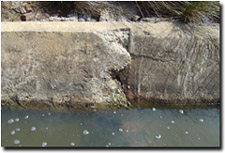Buildings and Structures
Indicators of Urban Salinity Home
White staining or marks on the surface of bricks and mortar may be crystallised salts. Salts can be deposited on the surface of these materials when water evaporates. This salt can derive from two possible sources:
- may be naturally present in the materials from the time of manufacture and water or rising damp brings it to the surface of the material; and/or
- may be present in the groundwater or irrigation water being absorbed by the brickwork.
 | Fig. 1: Small salt crystals forming on bricks and in mortar joints. This can lead to breakdown of mortar. |
Mechanical mortar breakdown can occur as a result of the growth of salt crystals. Lime mortars are particularly susceptible to rising damp which can cause the lime component to dissolve. Rising damp is caused by natural capillary action whereby moisture absorbent materials such as bricks, mortar or external renders draw moisture upwards from the ground. Moisture will continue to rise in the walls unless checked, bringing with it dissolved salt particles that have the potential to cause major damage if untreated. Stone structures may also be affected by rising damp and salinity, particularly sandstone and limestone, which are relatively porous and more readily absorb water.
 | Fig. 2: A granite block building suffering from accelerated erosion of the weakened mortar at the base of the building. Note also mechanical breakdown and staining of the granite blocks. |
Salts may appear as white stains on the surface of stone. Mechanical breakdown of the stone may occur due to the growth of salt crystals in its pores. Weathering can then cause grain by grain erosion of the stone surface. Alternatively, the outer layers of the stone may flake away due to the pressure of expanding salt crystals along the lines of weakness in the stone.
The 'tide mark' of rising damp and salinity may sometimes appear a lighter or bleached colour in some stones (Fig. 2) unlike brickwork, which is often darker when affected. The effects of high watertables and salinity is often most evident as rising damp. Figure 3 shows the typical 'tide mark' of rising damp. The height of the tide mark depends on the size of the pores in the building materials, the amount of water and the level of evaporation. Fig. 3: White staining from salt crystals, rising damp 'tidemark' and mortar loss. |  |
Materials that undergo numerous wetting and drying cycles (such as the brickwork pictured in Figs. 3 and 4) will accumulate more salt with each cycle. This leads to the break-up of the brickwork due to the pressure of growing salt crystals.
 | Fig. 4: Mechanical breakdown of brickwork caused by rising damp and the growth of salt crystals. |
Salinity and shallow watertables can even affect reinforced concrete. Particularly where the depth of the concrete over the reinforcing steel is inadequate or where the strength of the concrete is not high enough, thereby allowing water to penetrate. Water-borne salts which manage to penetrate through to the steel reinforcing can cause corrosion of the steel. As the steel rusts, it expands putting pressure on the concrete causing it to crack apart.
Concrete can also lose structure due to attack from sulphates. Sulphate salts are most common near wetlands or in coastal areas. Sulphates react chemically and physically with the cement in concrete leading to loosened aggregates and eventually a breakdown of the structure.
 | Fig. 5: Close-up of white staining (salt crystal growth) and damaged concrete. |
Fig. 6:- The breakdown of the concrete occurs most noticeably at a point of weakness - a join in the concrete drain. Located in a salinity discharge area, the drain is likely to suffer from accelerated weathering and damage. |  |


